Yunxin Liu
Institute for AI Industry Research, Shanghai AI Laboratory, Shanghai, China
EBT-Policy: Energy Unlocks Emergent Physical Reasoning Capabilities
Oct 31, 2025Abstract:Implicit policies parameterized by generative models, such as Diffusion Policy, have become the standard for policy learning and Vision-Language-Action (VLA) models in robotics. However, these approaches often suffer from high computational cost, exposure bias, and unstable inference dynamics, which lead to divergence under distribution shifts. Energy-Based Models (EBMs) address these issues by learning energy landscapes end-to-end and modeling equilibrium dynamics, offering improved robustness and reduced exposure bias. Yet, policies parameterized by EBMs have historically struggled to scale effectively. Recent work on Energy-Based Transformers (EBTs) demonstrates the scalability of EBMs to high-dimensional spaces, but their potential for solving core challenges in physically embodied models remains underexplored. We introduce a new energy-based architecture, EBT-Policy, that solves core issues in robotic and real-world settings. Across simulated and real-world tasks, EBT-Policy consistently outperforms diffusion-based policies, while requiring less training and inference computation. Remarkably, on some tasks it converges within just two inference steps, a 50x reduction compared to Diffusion Policy's 100. Moreover, EBT-Policy exhibits emergent capabilities not seen in prior models, such as zero-shot recovery from failed action sequences using only behavior cloning and without explicit retry training. By leveraging its scalar energy for uncertainty-aware inference and dynamic compute allocation, EBT-Policy offers a promising path toward robust, generalizable robot behavior under distribution shifts.
Leveraging AI Agents for Autonomous Networks: A Reference Architecture and Empirical Studies
Sep 10, 2025Abstract:The evolution toward Level 4 (L4) Autonomous Networks (AN) represents a strategic inflection point in telecommunications, where networks must transcend reactive automation to achieve genuine cognitive capabilities--fulfilling TM Forum's vision of self-configuring, self-healing, and self-optimizing systems that deliver zero-wait, zero-touch, and zero-fault services. This work bridges the gap between architectural theory and operational reality by implementing Joseph Sifakis's AN Agent reference architecture in a functional cognitive system, deploying coordinated proactive-reactive runtimes driven by hybrid knowledge representation. Through an empirical case study of a Radio Access Network (RAN) Link Adaptation (LA) Agent, we validate this framework's transformative potential: demonstrating sub-10 ms real-time control in 5G NR sub-6 GHz while achieving 6% higher downlink throughput than Outer Loop Link Adaptation (OLLA) algorithms and 67% Block Error Rate (BLER) reduction for ultra-reliable services through dynamic Modulation and Coding Scheme (MCS) optimization. These improvements confirm the architecture's viability in overcoming traditional autonomy barriers and advancing critical L4-enabling capabilities toward next-generation objectives.
BudgetThinker: Empowering Budget-aware LLM Reasoning with Control Tokens
Aug 24, 2025Abstract:Recent advancements in Large Language Models (LLMs) have leveraged increased test-time computation to enhance reasoning capabilities, a strategy that, while effective, incurs significant latency and resource costs, limiting their applicability in real-world time-constrained or cost-sensitive scenarios. This paper introduces BudgetThinker, a novel framework designed to empower LLMs with budget-aware reasoning, enabling precise control over the length of their thought processes. We propose a methodology that periodically inserts special control tokens during inference to continuously inform the model of its remaining token budget. This approach is coupled with a comprehensive two-stage training pipeline, beginning with Supervised Fine-Tuning (SFT) to familiarize the model with budget constraints, followed by a curriculum-based Reinforcement Learning (RL) phase that utilizes a length-aware reward function to optimize for both accuracy and budget adherence. We demonstrate that BudgetThinker significantly surpasses strong baselines in maintaining performance across a variety of reasoning budgets on challenging mathematical benchmarks. Our method provides a scalable and effective solution for developing efficient and controllable LLM reasoning, making advanced models more practical for deployment in resource-constrained and real-time environments.
GRAIL:Learning to Interact with Large Knowledge Graphs for Retrieval Augmented Reasoning
Aug 07, 2025Abstract:Large Language Models (LLMs) integrated with Retrieval-Augmented Generation (RAG) techniques have exhibited remarkable performance across a wide range of domains. However, existing RAG approaches primarily operate on unstructured data and demonstrate limited capability in handling structured knowledge such as knowledge graphs. Meanwhile, current graph retrieval methods fundamentally struggle to capture holistic graph structures while simultaneously facing precision control challenges that manifest as either critical information gaps or excessive redundant connections, collectively undermining reasoning performance. To address this challenge, we propose GRAIL: Graph-Retrieval Augmented Interactive Learning, a framework designed to interact with large-scale graphs for retrieval-augmented reasoning. Specifically, GRAIL integrates LLM-guided random exploration with path filtering to establish a data synthesis pipeline, where a fine-grained reasoning trajectory is automatically generated for each task. Based on the synthesized data, we then employ a two-stage training process to learn a policy that dynamically decides the optimal actions at each reasoning step. The overall objective of precision-conciseness balance in graph retrieval is decoupled into fine-grained process-supervised rewards to enhance data efficiency and training stability. In practical deployment, GRAIL adopts an interactive retrieval paradigm, enabling the model to autonomously explore graph paths while dynamically balancing retrieval breadth and precision. Extensive experiments have shown that GRAIL achieves an average accuracy improvement of 21.01% and F1 improvement of 22.43% on three knowledge graph question-answering datasets. Our source code and datasets is available at https://github.com/Changgeww/GRAIL.
Sculptor: Empowering LLMs with Cognitive Agency via Active Context Management
Aug 06, 2025Abstract:Large Language Models (LLMs) suffer from significant performance degradation when processing long contexts due to proactive interference, where irrelevant information in earlier parts of the context disrupts reasoning and memory recall. While most research focuses on external memory systems to augment LLMs' capabilities, we propose a complementary approach: empowering LLMs with Active Context Management (ACM) tools to actively sculpt their internal working memory. We introduce Sculptor, a framework that equips LLMs with three categories of tools: (1) context fragmentation, (2) summary, hide, and restore, and (3) intelligent search. Our approach enables LLMs to proactively manage their attention and working memory, analogous to how humans selectively focus on relevant information while filtering out distractions. Experimental evaluation on information-sparse benchmarks-PI-LLM (proactive interference) and NeedleBench Multi-Needle Reasoning-demonstrates that Sculptor significantly improves performance even without specific training, leveraging LLMs' inherent tool calling generalization capabilities. By enabling Active Context Management, Sculptor not only mitigates proactive interference but also provides a cognitive foundation for more reliable reasoning across diverse long-context tasks-highlighting that explicit context-control strategies, rather than merely larger token windows, are key to robustness at scale.
Mobile-Bench-v2: A More Realistic and Comprehensive Benchmark for VLM-based Mobile Agents
May 17, 2025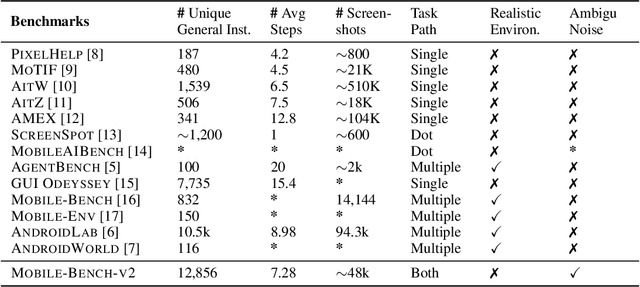
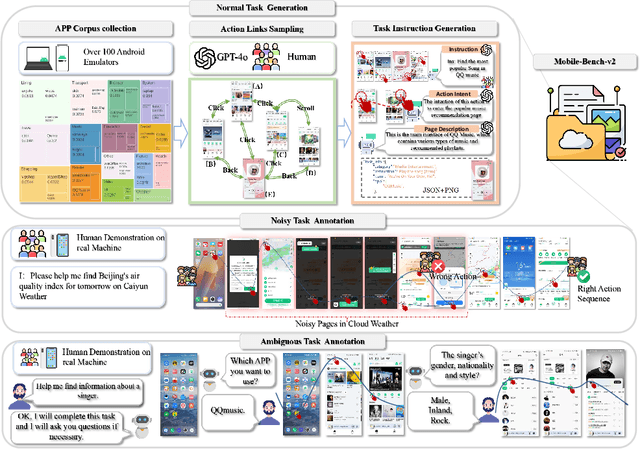
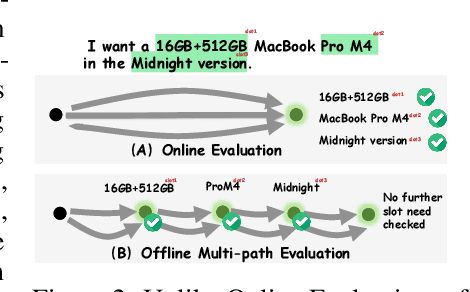

Abstract:VLM-based mobile agents are increasingly popular due to their capabilities to interact with smartphone GUIs and XML-structured texts and to complete daily tasks. However, existing online benchmarks struggle with obtaining stable reward signals due to dynamic environmental changes. Offline benchmarks evaluate the agents through single-path trajectories, which stands in contrast to the inherently multi-solution characteristics of GUI tasks. Additionally, both types of benchmarks fail to assess whether mobile agents can handle noise or engage in proactive interactions due to a lack of noisy apps or overly full instructions during the evaluation process. To address these limitations, we use a slot-based instruction generation method to construct a more realistic and comprehensive benchmark named Mobile-Bench-v2. Mobile-Bench-v2 includes a common task split, with offline multi-path evaluation to assess the agent's ability to obtain step rewards during task execution. It contains a noisy split based on pop-ups and ads apps, and a contaminated split named AITZ-Noise to formulate a real noisy environment. Furthermore, an ambiguous instruction split with preset Q\&A interactions is released to evaluate the agent's proactive interaction capabilities. We conduct evaluations on these splits using the single-agent framework AppAgent-v1, the multi-agent framework Mobile-Agent-v2, as well as other mobile agents such as UI-Tars and OS-Atlas. Code and data are available at https://huggingface.co/datasets/xwk123/MobileBench-v2.
LLM-Explorer: Towards Efficient and Affordable LLM-based Exploration for Mobile Apps
May 15, 2025Abstract:Large language models (LLMs) have opened new opportunities for automated mobile app exploration, an important and challenging problem that used to suffer from the difficulty of generating meaningful UI interactions. However, existing LLM-based exploration approaches rely heavily on LLMs to generate actions in almost every step, leading to a huge cost of token fees and computational resources. We argue that such extensive usage of LLMs is neither necessary nor effective, since many actions during exploration do not require, or may even be biased by the abilities of LLMs. Further, based on the insight that a precise and compact knowledge plays the central role for effective exploration, we introduce LLM-Explorer, a new exploration agent designed for efficiency and affordability. LLM-Explorer uses LLMs primarily for maintaining the knowledge instead of generating actions, and knowledge is used to guide action generation in a LLM-less manner. Based on a comparison with 5 strong baselines on 20 typical apps, LLM-Explorer was able to achieve the fastest and highest coverage among all automated app explorers, with over 148x lower cost than the state-of-the-art LLM-based approach.
Time's Up! An Empirical Study of LLM Reasoning Ability Under Output Length Constraint
Apr 22, 2025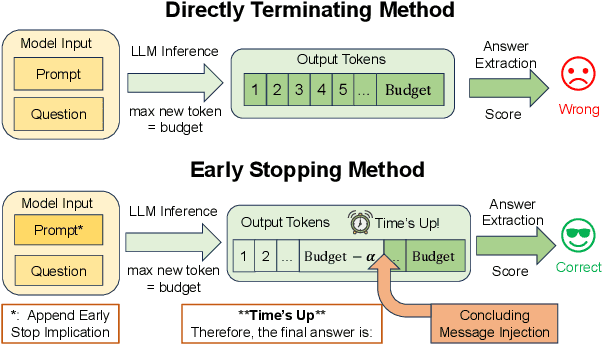
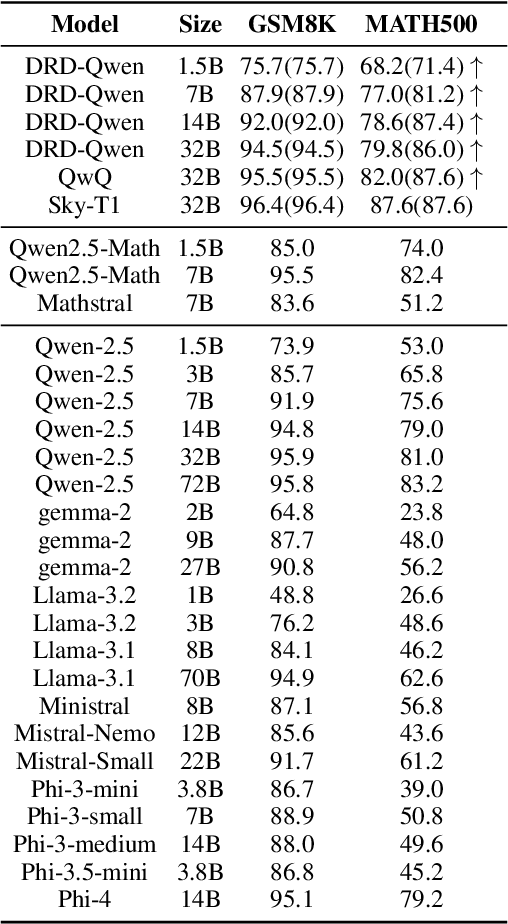
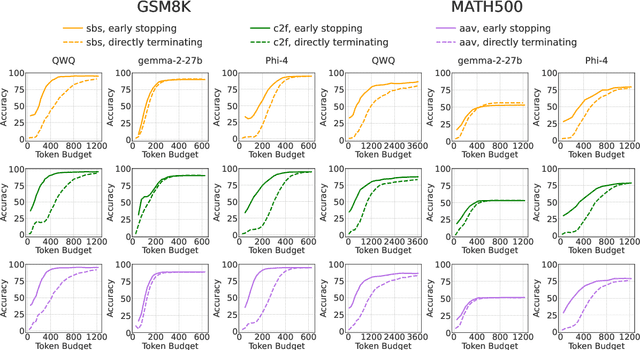
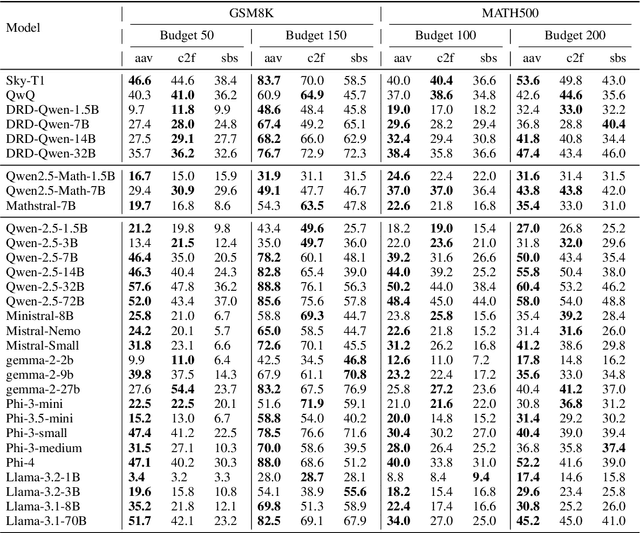
Abstract:Recent work has demonstrated the remarkable potential of Large Language Models (LLMs) in test-time scaling. By making the models think before answering, they are able to achieve much higher accuracy with extra inference computation. However, in many real-world scenarios, models are used under time constraints, where an answer should be given to the user within a certain output length. It is unclear whether and how the reasoning abilities of LLMs remain effective under such constraints. We take a first look at this problem by conducting an in-depth empirical study. Specifically, we test more than 25 LLMs on common reasoning datasets under a wide range of output length budgets, and we analyze the correlation between the inference accuracy and various properties including model type, model size, prompt style, etc. We also consider the mappings between the token budgets and the actual on-device latency budgets. The results have demonstrated several interesting findings regarding the budget-aware LLM reasoning that differ from the unconstrained situation, e.g. the optimal choices of model sizes and prompts change under different budgets. These findings offer practical guidance for users to deploy LLMs under real-world latency constraints.
Scaling Up On-Device LLMs via Active-Weight Swapping Between DRAM and Flash
Apr 11, 2025Abstract:Large language models (LLMs) are increasingly being deployed on mobile devices, but the limited DRAM capacity constrains the deployable model size. This paper introduces ActiveFlow, the first LLM inference framework that can achieve adaptive DRAM usage for modern LLMs (not ReLU-based), enabling the scaling up of deployable model sizes. The framework is based on the novel concept of active weight DRAM-flash swapping and incorporates three novel techniques: (1) Cross-layer active weights preloading. It uses the activations from the current layer to predict the active weights of several subsequent layers, enabling computation and data loading to overlap, as well as facilitating large I/O transfers. (2) Sparsity-aware self-distillation. It adjusts the active weights to align with the dense-model output distribution, compensating for approximations introduced by contextual sparsity. (3) Active weight DRAM-flash swapping pipeline. It orchestrates the DRAM space allocation among the hot weight cache, preloaded active weights, and computation-involved weights based on available memory. Results show ActiveFlow achieves the performance-cost Pareto frontier compared to existing efficiency optimization methods.
STRIDE: Automating Reward Design, Deep Reinforcement Learning Training and Feedback Optimization in Humanoid Robotics Locomotion
Feb 10, 2025



Abstract:Humanoid robotics presents significant challenges in artificial intelligence, requiring precise coordination and control of high-degree-of-freedom systems. Designing effective reward functions for deep reinforcement learning (DRL) in this domain remains a critical bottleneck, demanding extensive manual effort, domain expertise, and iterative refinement. To overcome these challenges, we introduce STRIDE, a novel framework built on agentic engineering to automate reward design, DRL training, and feedback optimization for humanoid robot locomotion tasks. By combining the structured principles of agentic engineering with large language models (LLMs) for code-writing, zero-shot generation, and in-context optimization, STRIDE generates, evaluates, and iteratively refines reward functions without relying on task-specific prompts or templates. Across diverse environments featuring humanoid robot morphologies, STRIDE outperforms the state-of-the-art reward design framework EUREKA, achieving significant improvements in efficiency and task performance. Using STRIDE-generated rewards, simulated humanoid robots achieve sprint-level locomotion across complex terrains, highlighting its ability to advance DRL workflows and humanoid robotics research.
 Add to Chrome
Add to Chrome Add to Firefox
Add to Firefox Add to Edge
Add to Edge